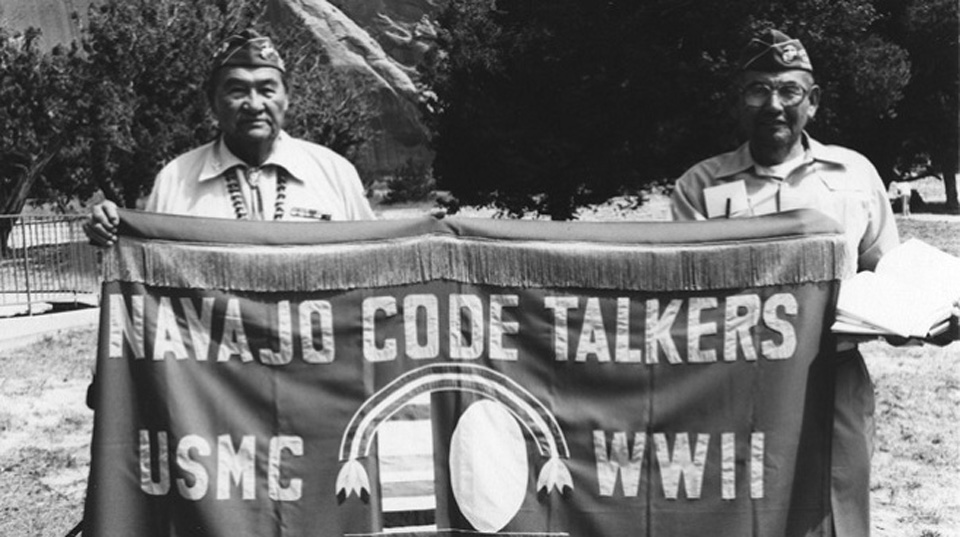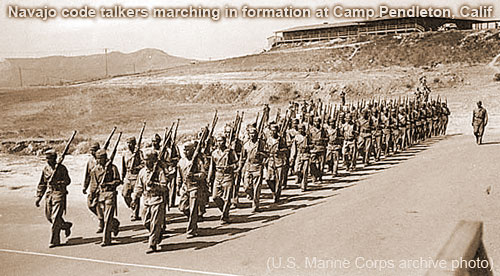
Unbreakable Voices: The Enduring Legacy of the Navajo Code Talkers
In the unforgiving crucible of World War II’s Pacific Theater, where every second counted and intelligence was paramount, the United States faced a persistent and deadly challenge: secure communication. Japanese cryptographers were notoriously adept, routinely breaking American military codes, costing countless lives and jeopardizing critical operations. From this dire need emerged one of the war’s most ingenious and ultimately unbreakable solutions: the Navajo Code Talkers, a group of Native American Marines whose unique linguistic heritage became an invaluable weapon against the Axis powers. Their story is a testament to ingenuity, bravery, and the profound, often overlooked, contributions of indigenous peoples to national defense.
The genesis of the Navajo Code Talkers program can be traced to a single, pivotal idea in early 1942. Philip Johnston, a WWI veteran and son of a missionary to the Navajo Nation, understood the profound complexity and obscurity of the Navajo language. Having grown up on the reservation, he was keenly aware that Navajo was an unwritten language, with no alphabet or published grammar, and understood by virtually no one outside the Navajo community. Crucially, it had no connection to any European or Asian language families, making it an utterly alien and impenetrable tongue to Japanese linguists. Johnston proposed to Major General Clayton B. Vogel, commanding general of Amphibious Corps, Pacific Fleet, that Navajo speakers could create an unbreakable code.
Skeptical but desperate, the Marine Corps authorized a small pilot program. In May 1942, 29 young Navajo men, known as the "Original 29," were recruited. They were brought to Camp Pendleton, California, where their initial task was not just to communicate in Navajo, but to create a code within their language. This "code within a code" involved two main components. First, they developed an alphabet, assigning Navajo words to represent English letters. For example, "A" became wol-la-chee (ant), "B" became shush (bear), and "C" became moasi (cat). This allowed them to spell out specific names or terms that didn’t have a direct Navajo equivalent. Second, and more importantly, they created a lexicon of approximately 200 terms for military equipment, tactics, and concepts that had no parallel in the pastoral Navajo world. "Bomb" became a-ye-shi (egg), "grenade" became nimasi (potato), "submarine" became besh-lo (iron fish), and "tank" became chay-da-gahi (turtle). This comprehensive vocabulary allowed for rapid and unambiguous transmission of complex messages.
The brilliance of the code lay in its inherent structure. It wasn’t simply a substitution cipher; it was a living, evolving language used by fluent speakers. The Code Talkers didn’t translate word-for-word; they transmitted concepts, sentences, and commands using the agreed-upon Navajo terms. This process was incredibly fast and virtually impossible to decipher without a deep understanding of the Navajo language itself, combined with knowledge of the specific military lexicon they had developed and memorized. While American encryption machines of the era required hours to encode, transmit, and decode a single message, the Navajo Code Talkers could relay a complex message in a matter of minutes, often seconds, under intense battlefield conditions.
After rigorous training and memorization, the first group of Code Talkers deployed to the Pacific Theater. Their impact was immediate and profound. They served in every major Marine assault from 1942 to 1945, including Guadalcanal, Tarawa, Saipan, Guam, Peleliu, Iwo Jima, and Okinawa. Their presence was crucial for coordination, particularly during the ferocious island-hopping campaigns where rapid communication was often the difference between success and catastrophic failure. At Iwo Jima, one of the bloodiest battles of the war, six Navajo Code Talkers worked tirelessly for 48 hours straight during the first two days of the assault, transmitting over 800 messages without a single error. Major General Howard M. Smith, commanding the 5th Marine Division at Iwo Jima, famously stated, "Were it not for the Navajos, the Marines would never have taken Iwo Jima." This sentiment was echoed by commanders across the Pacific, who lauded the Code Talkers for their speed, accuracy, and absolute reliability.

Beyond their technical prowess, the Code Talkers were also highly effective Marines. They faced the same dangers and hardships as their fellow servicemen, often operating on the front lines, carrying heavy radio equipment, and enduring brutal combat. Yet, they carried an additional burden: the constant demand for secrecy. So vital was their code that each Code Talker was assigned a personal guard to protect them – and to prevent their capture. The fear was that if a Code Talker fell into enemy hands, the Japanese might torture the code out of him, or worse, force him to transmit false messages. This extreme security measure underscored the immense value placed on their unique abilities.
Despite their critical contributions, the Code Talkers’ service remained a classified secret for decades after the war. The military recognized the potential need for such a code in future conflicts, and thus, the men were ordered not to speak of their wartime roles. They returned home, often without fanfare or special recognition, carrying the weight of their experiences and the silence of their classified service. Many struggled to reintegrate into a society that often discriminated against Native Americans, and few understood the profound impact they had made.
It wasn’t until 1968 that the program was declassified, and the story of the Navajo Code Talkers slowly began to emerge. Initially, public awareness was limited, but over time, their extraordinary tale gained national and international recognition. In 1982, President Ronald Reagan honored the Code Talkers for their unique contributions and declared August 14th "Navajo Code Talkers Day." The ultimate federal recognition came in 2000, when President Bill Clinton signed legislation awarding the Congressional Gold Medal to the original 29 Navajo Code Talkers, and Silver Medals to the approximately 300 other Code Talkers who followed. These long-overdue accolades finally acknowledged the valor, ingenuity, and patriotism of these remarkable men. Subsequent ceremonies, often attended by the surviving Code Talkers in their elderly years, served as poignant reminders of their sacrifice and resilience.
The legacy of the Navajo Code Talkers extends far beyond their wartime service. They stand as powerful symbols of how indigenous languages, often marginalized or endangered, can hold immense strategic value. Their story challenged prevailing stereotypes about Native Americans, demonstrating their profound loyalty and capacity for service to the United States, even while their communities often faced systemic discrimination. They showcased the strength that diversity brings to a nation, proving that unique cultural assets can be transformed into formidable strengths in times of crisis.
Today, the last surviving Navajo Code Talkers are revered national heroes, their lives a living bridge to a pivotal moment in history. Their story is taught in schools, celebrated in museums, and immortalized in film and literature, ensuring that future generations understand the extraordinary ingenuity and courage displayed by these guardians of an unbreakable code. The Navajo Code Talkers did more than just transmit messages; they forged a path to victory, demonstrated the enduring power of language, and etched an indelible mark on the annals of military history, proving that the most secure code often lies not in technology, but in the heart and heritage of a people.



